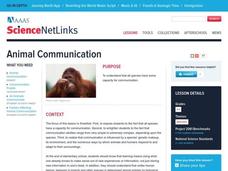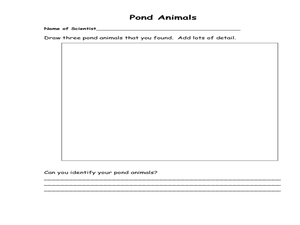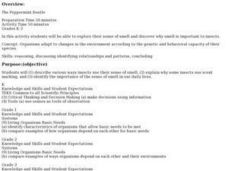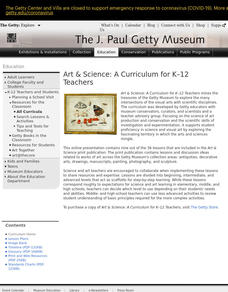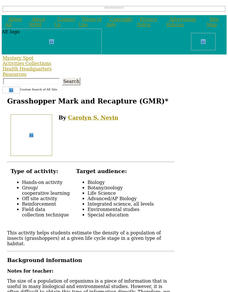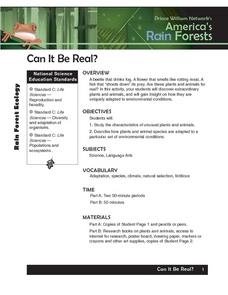Curated OER
When Is a Pest an Insect?
Students view the importance of insects as pollinators. They are now posed with the problem--those insects are nice--but insects are pests right? Students explore their description of pests and pesticides.
Curated OER
Pollination and Fertilization
Save yourself time by using this concise arrangement of slides about pollination and fertilization in plants. Minimal wording is included, but the graphics are educational. You will also find charts for the adaptations of both...
Curated OER
Biodiversity
Fifth graders visit the playground to look for signs of life. They search for insects, birds, animal tracks, feathers, nests, trees, soil, etc. They then compose a class list that shows all findings in the schoolyard and post it in the...
Curated OER
Symbiosis and Co-evolution
By choosing a species and researching an adaptive symbiotic relationship it shares with another species, your students are able to investigate a symbiotic relationship in a lab setting. They create a presentation using a variety of...
Curated OER
Animal Communication
Middle schoolers understand that all species have some capacity for communication. Students are exposed to the fact that all species have a capacity for communication. They are enlighten to the fact that communication abilities range...
Curated OER
Pets: Oh Behave
They say that a dog is a man's best friend. Why is that? Discuss with your class why people like pets and the responsibilities with owning one. They read an article about pet behavior and write a short essay comparing one of their...
Curated OER
Chapter 16, Food Biotechnology
Although the points given on these slides are valid, the visual accessibility is poor. Consequently, many viewers would be distracted or entirely unable to view the presentation. The content is a review of microorganisms and their...
Curated OER
Pond and Pond Organisms
Students explore pond ecosystems. In this pond organism activity, students will use pond water and a plastic bad in order to locate and identify freshwater organisms. The activity is designed for younger grades, but...
Curated OER
Body Parts of a Butterfly
Students identify the seven major parts of a butterfly. For this butterfly anatomy lesson, students explore three dimensional models of butterflies and discuss the anatomy. Students view a PowerPoint for the anatomical parts of a...
Curated OER
Wanted!!
Fourth graders study insects in their habitats looking at survival characteristics and whether the insect is a predator or an herbivore. They investigate characteristics that improve the survival of a species and its ability to reproduce.
National Park Service
Biodiversity—Bee Week
If you want scholars to fall in love with bees, this is the unit for you! Celebrate bees with a full week of material—designed for the Next Generation Science Standards—that addresses the importance of pollination and fertilization....
Curated OER
The Peppermint Beetle
Students describe various ways insects use their sense of smell, and examine why some insects use scent marking. They conduct a scent hunt, searching for a particular scent on the trees on school grounds.
Curated OER
Discovering the Oasis
Students focus on the types of vegetation and animal life living around local water sources. This lesson can be adapted to any local water source, whether it be a lake, a river, stream or ocean. It has a particular focus on the bird...
Curated OER
Who's the Baddest?
Students are introduced to the realm of social insects, their role in the environment and the biological features that make them unique.
Curated OER
Learning About Animals' Bodies
Students research different animals (mammals, reptiles, amphibians, insects, birds, fish) and create books, murals, dioramas, puppets, and sculptures to illustrate the necessity of various body parts for overall survival. In this animal...
Curated OER
Clearly Classified
Young scholars review the classification system for living organisms and apply it the classification of insects and flowers in the still life by Ambrosius Bosschaert. They create a chart classifying the animals and plants in the painting...
Curated OER
Grasshopper Mark and Recapture (GMR)
Learners estimate the density of a population of insects (grasshoppers) at a given life cycle stage in a given type of habitat.
Curated OER
America's Rain Forests Can It Be Real?
Students examine the attributes of unusual plants and animals before determining how they are adapted to specific habitat. They complete an associated worksheet. They make posters with information that they find during research sessions.
Curated OER
Camouflage
Students observe first hand what it is like to be the prey and what he or she must do to blend in and make themselves less noticeable. They participate in a variety of hands-on activities which help them explain how insects hide...
Curated OER
Flower Power
Students explore the parts of flowers and how they reproduce. They dissect flowers and observe the reproductive organs. Students observe anthers and ovaries of Tiger Lilies under a microscope. They investigate how insects and other...
Curated OER
Brays Bayou Spiderwort Genetic Study
Students formulate hypothesis based upon data gathered by examining possible crosses of spiderworts using Punnett squares. They present explanations for physiological adaptations of spiderworts that resulted from interactions within the...
Curated OER
Too Bee Or Not To Bee
Students recognize that bees are important in the reproduction of plants and to the survival of animals. In this bee lesson, students become familiar with the parts of bees and how those adaptations help them pollinate plants....
Curated OER
Bees
Students design an experiment. In this bees lesson, students research pollination and work collaboratively to discover how bees aid in pollination. Students use tomato plants and create experimental designs. Lesson adaptations...
Curated OER
Bugs
Students explore the wonders of bugs. In this bug lesson, students examine various types of bugs. Students make crafts, sing songs, discuss nutrition, and investigate different types of insects.




